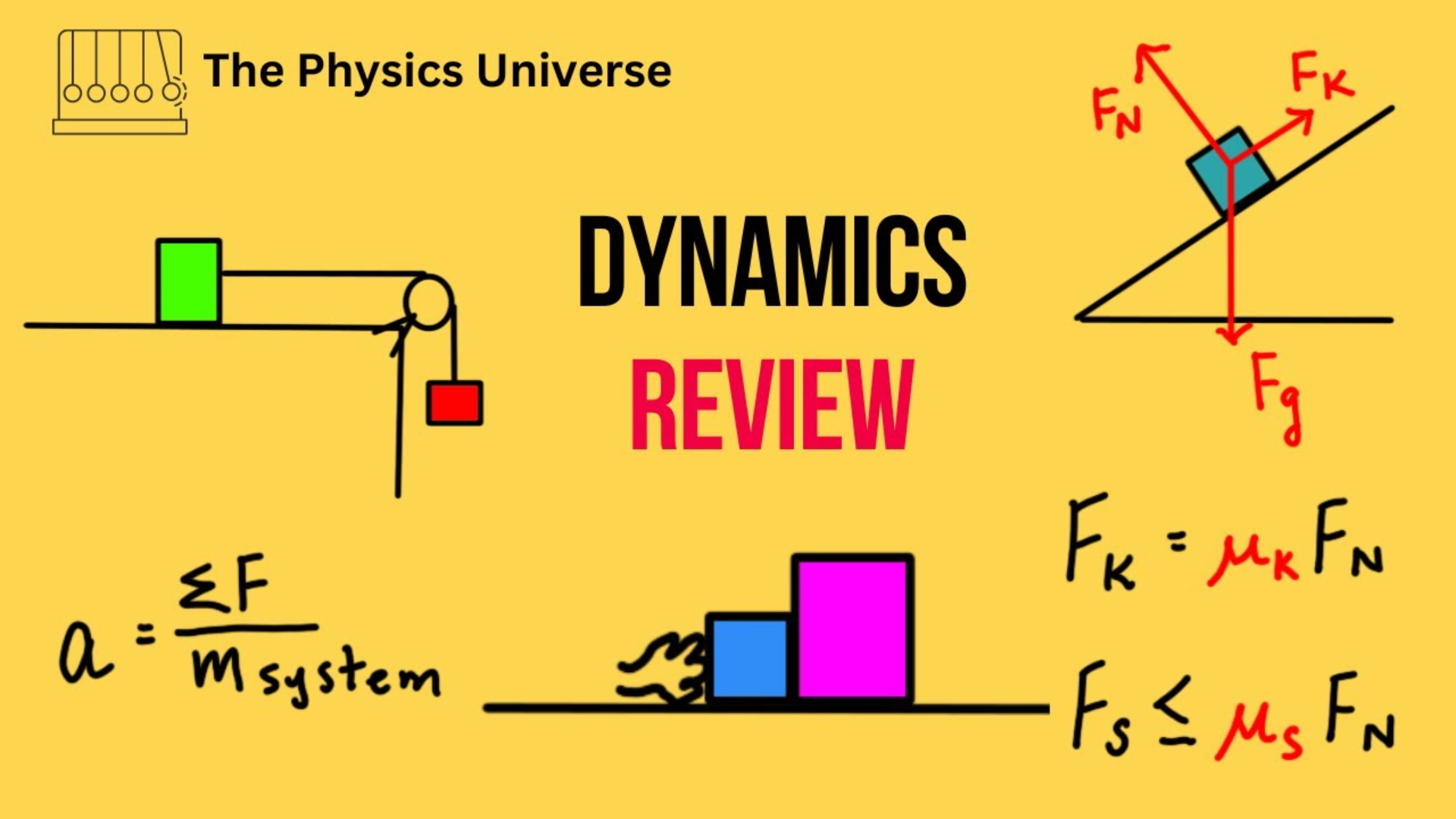Dynamics Physics Basic Concept

Mechanics
Mechanics is the branch of physics that deals with the study of motion, forces, and the behavior of physical systems.
It forms the foundation of classical physics and plays a crucial role in understanding various natural phenomena and engineering applications.
Rigid Body
When an external force acts on a body and the distance between the two points on the body doesn’t change, then the body is known as a Rigid Body.
Mechanics is the branch of physics which describes and predicts the conditions of rest or motion of bodies under the action of forces.
In a word, it is the branch of Physics dealing with the study of static body and its motion.
It turns out that everything that happens in the world is some type of motion.
Motion of blood in our body, motion of our eye, signal from brain, hand movement, all over motion,
students should be able to solve problems related to Newtons laws of motion, projectile motion, dynamics, circular and rotational motion, moment of inertia, linear momentum and angular momentum, moment,
torque, impulse etc.
Newton’s Laws of Motion
Isaac Newton (a 17th century scientist) put forth a variety of laws that explain why objects move (or don’t move) as they do. These three laws have become known as Newton’s three laws of motion.
Newton’s First Law of Motion:
Newton’s first law states that ‘an object will remain at rest or in uniform motion in a straight line unless acted upon by an external force’.
The tendency of a body to remain at rest or in uniform linear motion is called inertia,
and Newton’s first law is often called the law of inertia.
Basically what Newton’s First Law is saying is that objects behave predictably. If a
ball is sitting on your table, it isn’t going to start rolling or fall off the table unless a
force acts upon it to cause it to do so. Moving objects don’t change their direction
unless a force causes them to move from their path.
Newton’s Second Law of Motion:
Newton’s second law states that ‘The rate of change of momentum of a body is directly proportional to the impressed force and takes place in the direction of the force.’
When a force acts on an object, it will cause the object to accelerate. The larger the
mass of the object, the greater the force will need to be to cause it to accelerate.
This Law may be written as, force = mass x acceleration
or: F = m a
If you apply more force to an object, it accelerates at a higher rate. If the same force
is applied to an object with greater mass, the object accelerates at a slower rate
because mass adds inertia.
Newton’s Third Law of Motion:
Newton’s third Law of Motion states that ‘for every action, there is an equal and opposite reaction’.
When one body exerts a force on a second body, the second body simultaneously
exerts a force equal in magnitude and opposite in direction on the first body.
Force:
Force is a kind of impact, external or internal which tends to change or in real sense.
it changes the state of rest or uniform motion of a body in a straight line i. e. it
changes the inertia of any object.
Forces can be used to increase the speed of an object, decrease the speed of an object,
or change the direction in which an object is moving.
Force is a vector quantity. The unit of force is Newton (N).
Momentum
The momentum of a particle is defined as the product of its mass times its velocity.
The linear momentum is a vector quantity, possessing a direction as well as a
magnitude,
Momentum = mass x velocity
P = mv
It’s direction along the direction of velocity. The SI unit for momentum is kg m/s.
Linear momentum is also a conserved quantity, meaning that if a closed system is
not affected by external forces, its total linear momentum cannot change.
Galileo’s Laws of Motion
Galileo (1564-1642) was the first to determine, at the start of the seventeenth century, the law of constant acceleration of free-falling bodies. Galileo gave three laws about falling bodies. These are called Galileo’s laws in the case of falling bodies. These Laws are applicable to freely falling bodies. The law states that the distances traveled are proportional to the squares of the elapsed times.
Laws are given below:
First law: In a vacuum, all the freely falling bodies starting from rest traverse equal distance at equal interval of time or, in a vacuum all bodies starting from rest fall with equal rapidity.
Explanation: According to this law if different objects having different sizes, namely volumes are allowed to fall from rest at a particular height and without any resistance will reach the ground at the same time. The first law can be proved by the guinea and feather experiment.
Second law: Starling from rest, the velocity of a freely falling body is proportional to the time taken to fall. If a falling body gets velocity v at time t, it can be mathematically written as, v ∞ t.
Explanation: If a body is allowed to fall freely from rest under the action of gravitational force, then if its velocity in one second is v, then the velocity in two seconds will be 2v, in three seconds 3v and so on. Generally, if the velocities of the falling body in t1, t2, t3 secs, are respectively v1, v2, v3 then we find,
v1/t1 = v2/t2 = v3/t3
So, v ∞ t
Third law: Starting from rest, the distance traversed by a freely falling body is proportional to the square of the time of fall. If a falling body traverses distance h in time t, it can be mathematically written as, h ∞ t2.
Explanation: Under gravitational attraction, if a body, initially at rest, is allowed to fall freely then the body will traverse distance h in 1 sec., distance 22 x h in 2 sec., 32 x h in 3 sec. and so on. In other words, in equal successive periods of time, the distances traveled by a free-falling body are proportional to the succession of odd numbers (1, 3, 5, 7, etc.). So if the body traverses distances h1, h2, and h respectively, in t1, t2, t3 secs., then,
h1/t12 = h2/t22 = h3/t32
so, h ∞ t2.
Software engineers may need physics because it helps with
• logical thinking,
• debugging issues,
• solving complex problems, and
• working with physics-related applications.
Having a deep understanding of physics won’t make you an amazing software engineer. However, it can help develop certain abilities that will help you improve.
Motion: Describes how objects move in space and time. It involves concepts like displacement, velocity, and acceleration.
Forces: Influences that cause changes in motion. Newton’s laws of motion govern the relationship between forces and motion.
Energy: The ability to do work or cause changes in a system. It exists in different forms, such as kinetic, potential, and mechanical
energy.
Momentum: A property of moving objects that depends on their mass and velocity. Conservation of momentum is an essential principle in mechanics.
Equilibrium and Statics:
Equilibrium: Occurs when them net force and net torque acting on an object are both zero. Objects in equilibrium do not accelerate.
Statics: The study of systems in equilibrium, where forces are balanced and there is no motion.
Kinematics: Describes the motion of objects without considering the forces causing it.
Involves concepts like displacement, velocity, acceleration, and time. Formulas for uniformly accelerated motion are crucial in
solving kinematic problems.
Dynamics: Focuses on understanding the forces that cause motion and their effects on objects.
Involves the application of Newton’s laws of motion to analyze real-world scenarios.
Work: The product of force and displacement along the direction of the force.
Energy: The capacity to do work. Mechanical energy is the sum of kinetic and potential energy.
Power: The rate at which work is done or energy is transferred.
What is a Rigid Body?
When an external force acts on a body and the distance between the two points on the body doesn’t change, then the body is known as a Rigid Body.
Or it can be said that a body that does not change shape under the influence of forces is known as a Rigid Body.
CONCEPT OF A POINT MASS OR PARTICLE
If a particle is moving along a curved path in a plane, then it is said to be in two dimensional motion.
MOTION CLASSIFICATION: DIMENSION CLASSIFICATION OF MOTION SCALAR
Scalar quantities are the Physical quantities
which is complete with a magnitude alone. Mass, Temperature, Energy, Work, Pressure
The mass of my body is 60 kg means my body is made up of matter 60kg. It doesn’t need any more explanation.
VECTOR
Vector quantity is the one which need a direction for completing its existence.
Velocity, Force/ Weight, Acceleration.
My weight is 600 N means, I am pulled towards earth with a force of 600N. It is not complete unless it is specified towards Earth.
Parameters of Motion
Position
Distance
Displacement
Speed (average, instantaneous)
Velocity (average, instantaneous)
Acceleration (average, instantaneous)
Distance & Displacement
Displacement is the shortest distance i.e. the difference in position of the object. It is the straight line
distance between the initial and final positions of an object. It is a vector quantity.
Distance is the length of the path followed by the object. It is a scalar quantity.
DIFFERENCE BETWEEN DISTANCE & DISPLACEMENT
Distance ≥ Displacement
Example: Calculate the displacement vector
for a particle moving from a point P to Q as
shown below. Calculate the magnitude of
displacement.
Example: An athlete covers 3 rounds on a circular track of radius 50 m. Calculate the total distance and displacement
travelled by him.
Solution: The total distance the athlete covered =3x circumference of track
The displacement is zero, since the athlete reaches the same point A after three rounds from where he started.
SPEED
Speed is the rate of change of distance or the distance covered per unit time
• Speed is the total distance
(s) covered in total time (t)
Differentiate between reference point a frame of reference. Locate a point (-3, -4) in a reference frame.
Reference Point:
- A reference point is a specific, identifiable location used as a starting point to describe the position or motion of objects.
- Nature: It is a singular point chosen as a baseline for measurements.
- Role: It serves as a point of comparison for determining the location of other objects.
- Example: In a Cartesian coordinate system, the origin (0, 0) is a common reference point.
Frame of Reference:
- Definition: A frame of reference is a coordinate system used to specify the location or motion of objects relative to a set of axes.
- Nature: It is a broader concept that includes multiple points, axes, and a coordinate system.
- Role: It provides a spatial context for describing the position, velocity, and acceleration of objects.
- Example: The coordinate system in which you describe the motion of a car on a road.
to locate the point (-3, -4) in a reference frame:
- A Cartesian coordinate system with an x-axis and a y-axis.
- Start from the reference point (0, 0), which is the origin.
- Move 3 units to the left along the x-axis (negative direction) from the origin.
- Then, move 4 units downward along the y-axis (negative direction) from the x-axis position reached.
- The resulting point (-3, -4) is now located in the reference frame.
A reference point is a specific location used as a starting point for measurements, while a frame of reference is a coordinate system providing a spatial context. The point (-3, -4) is located by moving from the reference point within a reference frame.
What is the condition for circular motion to exist?
Circular motion exists when an object travels along a circular path with a constant speed, experiencing a centripetal force directed toward the center of the circle. The object’s inertia and centripetal acceleration maintain this motion, requiring sufficient tangential velocity and a central force field.
Circular motion exists when an object moves along a circular path, maintaining a constant distance from a fixed point known as the center of the circle. For circular motion to occur, certain conditions must be met:
1. **Constant Speed:** The object must move at a constant speed. While the speed remains constant, the direction of motion continuously changes, leading to circular motion.
2. **Centripetal Force:** There must be a centripetal force acting on the object, directing it towards the center of the circular path. This force is necessary to keep the object in circular motion and counteract its tendency to move in a straight line.
3. **Central Force Field:** The centripetal force is often provided by a central force field, such as gravitational force or tension in a string. This force is always directed toward the center of the circular path.
4. **Inertia and Centripetal Acceleration:** The object’s inertia, wanting to move in a straight line, is overcome by the centripetal force, causing it to continuously change direction. The acceleration of the object is directed toward the center of the circle and is called centripetal acceleration.
5. **Sufficient Tangential Velocity:** The object must have sufficient tangential velocity, which is the component of velocity tangent to the circular path. This velocity, combined with the centripetal force, maintains the circular motion.
These conditions collectively ensure that an object moves in a circular path rather than a straight line. It’s important to note that if any of these conditions is not met, the circular motion may not be sustained.
Define force. Characteristics of a force? Derive the impulse momentum formula.
**Force:**
Force is a push or pull with both magnitude and direction.
**Characteristics:**
1. Magnitude (strength).
2. Direction (line of action).
3. Point of application.
4. Contact or action-at-a-distance nature.
**Impulse-Momentum Formula Derivation:**
Impulse (\( \Delta p \)) is equal to force (\( F \)) multiplied by the time (\( \Delta t \)) the force is applied:
\[ \Delta p = F \times \Delta t \]
This derives from Newton’s second law (\( F = ma \)), expressing force as the rate of change of momentum.
**Force Definition:**
Force is a push or pull applied to an object that can change its state of motion or shape. It is a vector quantity, meaning it has both magnitude and direction.
**Characteristics of a Force:**
1. **Magnitude:** The strength or size of the force, measured in newtons (N).
2. **Direction:** The line along which the force is applied, represented by an arrow.
3. **Point of Application:** The specific point where the force is applied on an object.
4. **Contact or Action-at-a-distance:** Forces can result from direct contact between objects or act at a distance (e.g., gravitational force).
**Impulse-Momentum Formula Derivation (Short Answer):**
The impulse-momentum theorem states that the change in momentum of an object is equal to the impulse applied to it. Mathematically, this is expressed as:
Impulse(Delta p) = Force*Time
Now, considering Newton’s second law (\( F = ma \)), we can express force as the rate of change of momentum:
F = Delta p/Delta t
Rearranging, we get:
\[ \Delta p = F \times \Delta t \]
This equation is the impulse-momentum formula, where:
– \( \Delta p \) is the change in momentum,
– \( F \) is the force applied, and
– \( \Delta t \) is the time the force is applied.
What are the limitations of 2nd law of motion? Derive second law of motion.
**Limitations of Newton’s Second Law:**
1. Applicable mainly to particles.
2. Assumes constant mass.
3. Assumes force is directly proportional to acceleration.
4. Not suitable for forces depending on higher derivatives.
**Derivation of Newton’s Second Law:**
Newton’s second law (\(F = ma\)) states that force is the product of mass and acceleration. Derived from the relationship between force, mass, and acceleration, it expresses how an applied force causes a change in motion.
Limitations of Newton’s Second Law:
1. **Applicability:** Newton’s second law is strictly applicable to particles or point masses and may not be directly applicable to objects with changing shapes.
2. **Constant Mass:** It assumes constant mass, which might not be the case in certain relativistic or extreme physical conditions.
3. **Acceleration Dependency:** The equation assumes that force is directly proportional to acceleration, which might not hold in some situations.
4. **Not for All Forces:** The law doesn’t account for forces that depend on higher derivatives of position (higher than the second derivative).
**Derivation of Newton’s Second Law (Short Answer):**
Newton’s second law states that the force acting on an object is equal to the mass of that object multiplied by its acceleration. Mathematically, it is expressed as:
\[ F = ma \]
Where:
– F is the force applied,
– m is the mass of the object, and
– a is its acceleration.
The law is derived from the fundamental principles of classical mechanics and the relationship between force, mass, and acceleration. The basic idea is that the force required to accelerate an object is directly proportional to its mass and the acceleration applied.
Differentiate between impulsive force and impulse of a force.
| Characteristic | Impulsive Force | Impulse of a Force |
|---|---|---|
| Definition | A force applied over a very short duration, leading to a sudden change in momentum. | The product of force and the time over which the force is applied, causing a change in momentum. |
| Nature | Acts over an extremely brief time interval. | Represents the overall effect of a force acting over a specific time duration. |
| Duration | Very short duration, often considered instantaneous. | Duration is explicitly considered in the calculation (Δt in the impulse formula). |
| Effect on Momentum | Results in a rapid and significant change in momentum. | Represents the cumulative change in momentum caused by a force. |
| Mathematical Expression | F⋅Δ where Δ is the impulsive force. | F⋅Δ where Δ is the force and ΔF is the time. |
| Example | A ball hitting a wall and rebounding in a very short time. | A constant force applied to an object over a specified time period. |
An object travelling in circular motion with constant speed, determine its acceleration?
The acceleration of an object moving in circular motion with constant speed is directed toward the center of the circle and is called centripetal acceleration. Its magnitude (\(a_c\)) is given by the formula:
\[ a_c = \frac{v^2}{r} \]
where:
– \( v \) is the constant speed of the object, and
– \( r \) is the radius of the circular path.
Centripetal acceleration ensures that the object changes direction continuously while maintaining a constant speed.
What is the relation between distance and displacement?
| Characteristic | Distance | Displacement |
|---|---|---|
| Definition | The total path length traveled by an object, always positive or zero. | The change in position of an object; it has both magnitude and direction. |
| Scalar or Vector | Scalar (only magnitude) | Vector (magnitude and direction) |
| Symbol | � | Δ� (or �, �) |
| Units | Meters (m), kilometers (km), etc. | Meters (m), kilometers (km), etc. |
| Path Dependency | Path-dependent; it depends on the actual route taken. | Path-independent; it only considers the initial and final positions. |
| Always Positive | Non-negative; distance is always equal to or greater than zero. | Can be positive, negative, or zero, depending on the direction of displacement. |
| Example | If you walk 5 meters to the east, then 3 meters to the west, the total distance traveled is 8 meters. | If you walk 5 meters to the east, then 3 meters to the west, the displacement might be 2 meters to the east. |
| Instantaneous Value | Instantaneous speed can be found by calculating the distance traveled per unit time. | Instantaneous velocity is found by calculating the displacement per unit time, considering direction. |
Define radius of gyration and moment of inertia, why moment of inertia is so
important in rotational motion, what are the aspects influencing moment of inertia?
Derive moment of inertia of a circular disc
**Radius of Gyration:**
– *Definition:* \( k \) is the distance from the axis of rotation where the entire mass could be concentrated to yield the same moment of inertia.
**Moment of Inertia:**
– *Definition:* \( I \) measures an object’s resistance to changes in rotation, depending on its mass distribution around the axis.
**Importance:**
– *Significance:* Crucial in rotational motion, indicating how objects respond to external torques.
**Influencing Aspects:**
– *Factors:* Mass distribution, shape, and axis of rotation affect the moment of inertia.
**Derivation for Circular Disc:**
– *Formula:* \( I = \frac{1}{2}MR^2 \)
– *Explanation:* Reflects mass distribution in a circular disc and its resistance to rotational motion around its central axis.
Define com, torque and mention use of torque in our life. Derive the equation
of torque and show that torque depends on moment of inertia
**Center of Mass (COM):**
– *Definition:* The center of mass is the point in an object or system where its mass can be considered concentrated.
**Torque:**
– *Definition:* Torque is the rotational equivalent of force, causing an object to rotate around an axis. It depends on the force applied, the distance from the axis, and the angle.
**Use of Torque in Our Life:**
– *Example:* Turning a wrench, opening a door, or riding a bicycle involve the application of torque.
**Derivation of Torque Equation:**
– *Formula:* Torque (\(\tau\)) is given by \(\tau = r \times F \times \sin(\theta)\), where:
– \(r\) is the lever arm (distance from the axis),
– \(F\) is the force applied, and
– \(\theta\) is the angle between the force and the lever arm.
**Torque Depends on Moment of Inertia:**
– *Relationship:* Torque (\(\tau\)) is proportional to the product of moment of inertia (\(I\)) and angular acceleration (\(\alpha\)), expressed as \(\tau = I \times \alpha\).
– *Explanation:* This relationship shows that the torque required to change the rotation of an object depends on how its mass is distributed (moment of inertia).
Derive expression for KE of rotation
Derivation of Rotational Kinetic Energy (Short Answer): For an object rotating about a fixed axis, the rotational kinetic energy (rot) is given by:
rot=12 2
where:
- is the moment of inertia of the object,
- is the angular velocity of the object.
This equation parallels the linear kinetic energy equation (linear=12 2) but involves angular quantities for rotational motion. It represents the energy associated with the rotation of an object.
11. Compare linear and angular momentum. Prove principle of conservation of
angular momentum
| Characteristic | Linear Momentum | Angular Momentum |
|---|---|---|
| Quantity Symbol | (linear momentum) | (angular momentum) |
| Vector/Scalar | Vector | Vector |
| Definition | (product of mass and velocity) | (product of moment of inertia and angular velocity) |
| Units | kg·m/s (kilogram meter per second) | kg·m²/s (kilogram meter squared per second) |
| Conservation Principle | Conservation of linear momentum holds in isolated systems. | Conservation of angular momentum holds in isolated systems. |
| Application | Applicable to objects moving in a straight line. | Applicable to objects rotating about an axis. |
Mentions some applications of linear, circular and rotational motion
Applications of Linear Motion:
- Transportation: Vehicles moving in a straight line, such as cars, trains, and airplanes, involve linear motion.
- Projectile Motion: The motion of a thrown object, like a ball or a projectile, is a combination of linear and vertical motions.
- Conveyor Belts: Linear motion is used in conveyor belts to transport goods.
Applications of Circular Motion:
- Amusement Park Rides: Ferris wheels, carousels, and roller coasters involve circular motion.
- Planetary Orbits: Celestial bodies, like planets and moons, move in circular or elliptical orbits around a central mass.
- Spinning Objects: Objects like wheels, records, and hard drives involve circular motion.
Applications of Rotational Motion:
- Flywheels: Used in machinery to store rotational energy and stabilize rotational speed.
- Drilling: In drilling machines, the drill bit undergoes rotational motion.
- Gyroscope: Used in navigation systems and devices to maintain orientation and stability.
These applications demonstrate the diverse and practical uses of linear, circular, and rotational motion in various aspects of everyday life and technology.
What are the limitations of first law of motion?
Limitations of Newton’s First Law:
1. Inertia: The first law assumes perfect inertia, but in reality, some resistance to motion exists due to factors like friction and air resistance.
2. Constant Velocity: It doesn’t explain how an object maintains constant velocity under the influence of a net force.
3. Applicability: Strictly applicable only in inertial reference frames; non-inertial frames introduce complexities.
4. Quantification: It doesn’t provide a way to quantify the force needed to overcome inertia.
These limitations highlight specific scenarios where the first law’s simplicity may not fully describe real-world dynamics.
1. Action and Reaction: While the law states that every action has an equal and opposite reaction, the effects of these forces might be very different due to differences in mass and acceleration.
2. Not Always Applicable: The law may not be directly applicable in situations involving variable masses, relativistic speeds, or quantum scales.
3. Friction and Air Resistance: In the presence of friction or air resistance, the equal and opposite forces might not completely cancel out.
These limitations highlight cases where the simplicity of Newton’s third law may not fully capture the complexities of certain physical interactions.
Thanks for your time!






Leave a Reply